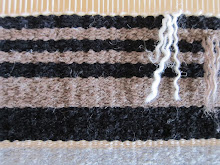I had a wonderful two days working with Betty Vera, who is an accomplished artist with a clear sense of her own direction and needs. Working one on one is such a give and take that I often wonder, who is teaching who? I like to think we are explorers together rather than mentor/mentee teacher/student or any other dichotomy. I knew both Betty and I had done extensive work using painted warps, but in very different ways, and it was fun to learn how often our lives unknowingly dovetailed. I am sure we have been in rooms together before but just didn't know each other.

Betty Vera discussing her lampas study

detail of Betty Vera's lampas study
The first day we spent going over the process of designing for Beljen Mills, which is also discussed in The Woven Pixel in detail. Betty is such a good colorist and it is going to be interesting to watch how she works with their warp tapestry setup which allows for pixelated abstraction in the imagery and color principles derived from pointillism. Since she has already done some work with this mill and others, she had a good grasp of what she needed clarifying. We made a set of weave structures using the black warp as the main color, running through all the possibilities of using it with other colors as binders, as well as the variations using dark and light wefts. In her own studio, she is now going to work on her 16-shaft loom to do some structure tests that she can incorporate into jacquard cloth.
The second day we worked with Photoshop and the TC-1 using The Woven Pixel processes. We took one of her images, a very diffused soft image with extreme pixelation of many colors and worked it into two variations that were woven using the ten structures I discussed recently for Double Plain Weave. I wasn't sure how the single pixels would work but was thrilled as her weaving progressed at the loom. I loved the cloth, and realized that she was creating an effect with solid black and white threads that was quite similar to one I had created by braiding black yarn and discharging the color. You can see details of Betty's cloth below, and one of my braided discharged pieces below that.

detail of Betty Vera's double plain weave study

detail of lampas weaving by Bhakti Ziek showing braided and discharged warps
After weaving the double plain weave, we returned to the computer and designed 10 lampas structures using three wefts (one ground and two pattern wefts). Because the TC-1 loom is set-up with an end and end, black and white, warp, I realized we could make 1:1 (1 ground warp to 1 binder warp) structures that sometimes brought the white warp up as either a warp-faced or weft-faced satin ground, and two more structures that could bring the black warp up as warp-faced or weft-faced satin ground. Then using the two pattern wefts, we made a 1/3 twill that showed both wefts together, one structure using the white warp as binder, another using the black warp as binder. Then four more structures, one that showed the first pattern weft alone in a 1/3 twill with the white warp, another with the black warp; another structure showing the second pattern weft alone in a 1/3 twill, first with the white warp then with the black warp. The beating of the wefts is such that three picks end up sitting on top of each other, so on the face of the cloth you will see pattern weft one alone, pattern weft two alone, the two pattern wefts together, the ground weft alone, or the ground warp--five variations showing black warp as ground, white warp as binder and five variations showing white warp as ground and black warp as binder. A detail of Betty's study is at the top of this post. Click on the detail to see the image enlarged (you can click on any image to see it enlarged--did you know that?).
So, although I get the credit for being the teacher these last few days, Betty's inquiries led me to new places and new insights. I am so enthusiastic about the cloth coming off my TC-1 these days that I honestly don't feel there are enough hours in the day to get my work done. Though I often suffer from lack of direction, this is a fertile time where there are too many ideas springing up. They come directly from the work. They come so fast that I forget to write them down in my notebook--to remind me what to do when the dry spell hits again. I guess when it does, that will probably be a time when the work has gotten interrupted by other life necessities. So if it happens, and I forget that I just need to get started working again, maybe one of you will be kind enough to write me a note reminding me that the work will generate its own ideas and paths--just get started.
By the way, that cake I mentioned last time, it did turn out to be perfectly delicious. I usually make it as a strawberry shortcake, but this time I used blueberries in the center and blackberries on top. It is all gone now and I am suffering from deprivation.







































